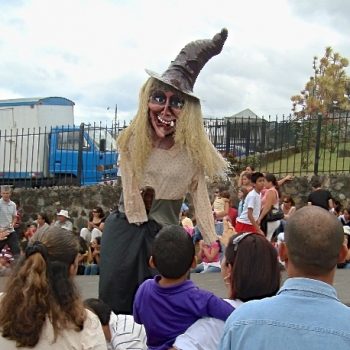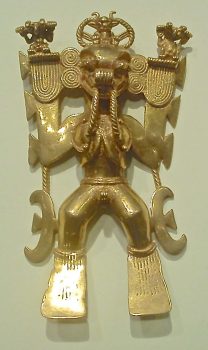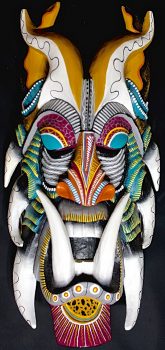Forget Halloween this 31st — it’s Time for Mascarada!

Witch on Parade
Image ![]() Wikipedia / Cropped & enhanced original
Wikipedia / Cropped & enhanced original
Halloween is not a traditional Costa Rican holiday, but with more exposure from tourism, ex-pats taking up residence, and the influence of the media, the celebrations are becoming more popular in the larger cities of Costa Rica. In San Jose, stores now carry costumes and children do dress up to “trick or treat” in their Central Valley condominiums. It is hard to imagine a Costa Rican egging or toilet papering anyone’s house for lack of good candy though. Some bars, especially in Escazu, San Pedro and Santa Ana, throw costume parties and contests for eager partygoers.
“Masquerade Day”, an annual event started in the colonial era of Costa Rica, where locals sport huge paper-maîché and clay mask heads, is celebrated on October 31st.
The techniques for making the masks are passed down through the family generations and artists carefully prepare their works of art months before the big day. The “masacaradas” typically are fashioned after popular characters, such as witches, TV personalities, and politicians whose caricatures take to the streets, chasing spectators to the rhythm of cimarronas (small bands playing traditional folk tunes). The “clowns” work the crowd as music flows through the air and vendors selling typical dishes line the streets. You might even see people dressed as some of the legends that are recounted at this time of year: El Cadejo, the black dog with big red eyes wrapped in chains or La Cegua, a woman dressed in white with long black hair and the head of a horse make terrifying masks.
Grandparents might choose this time of year to recount other legends in the evenings, around their rocking chairs, to give the children a fright, such as the devilish oxless cart that drives itself, creaking through, dooming anyone who encounters it. Perhaps they tell of “The Weeping Woman”, who while dressed in white, cries by a river’s edge where she drowned her own children after suffering from a broken heart.

Gold Pendant of a Shaman Wearing a Mask
Image ![]() Wikipedia / Enhanced original
Wikipedia / Enhanced original

Traditional Boruca Mask
Image ![]() Wikipedia / Enhanced original
Wikipedia / Enhanced original
The tradition’s roots come from a mix of indigenous ceremonies of the Boruca tribe and Spanish traditions. The Boruca tradition is to fashion masks from materials such as clay, jade, volcanic ash and wood representing their deities. A masked person performed ritual dances and was believed to be possessed by the “god” they were representing. The Costa Rican tradition was mixed with a Spanish version carried out in Cartago by entertainers or ”parliamentarians” who acted before bullfights and religious ceremonies. These performers would interact with the crowd while dressed in sheets, with holes for the eyes and mouth or paper maîche animal masks.
On August 2nd, 1824, Rafael Valerían organized the first “Mascarada” in Cartago to celebrate “La Negrita” or The Virgin of the Angels (The Virgin Mary). He was a craftsman of instruments and puppets and dedicated his life to perfecting the craft of masks that he passed on to his son, Jesus, who carried on his father’s work using clay, paper, wire and plaster that was poured into molds of the caricatures. Before his death, Jesus sold those molds to two brothers, Pedro and Manuel Freer, who expanded the traditions to other areas of Costa Rica, including San Jose.
In 1997, after an initiative by the Ministry of Cultural Affairs, the Costa Rican Traditional Masquerade National Day was established on October 31st in part to combat the influence of outside holidays like Halloween and instead promote internal traditions.
Now the festivities of National Masquerade Day can be enjoyed by all as people line the streets of Escazu to enjoy the enormous heads molded into scary gargoyles, devils and witches careening through the streets to the sound of folk music.




